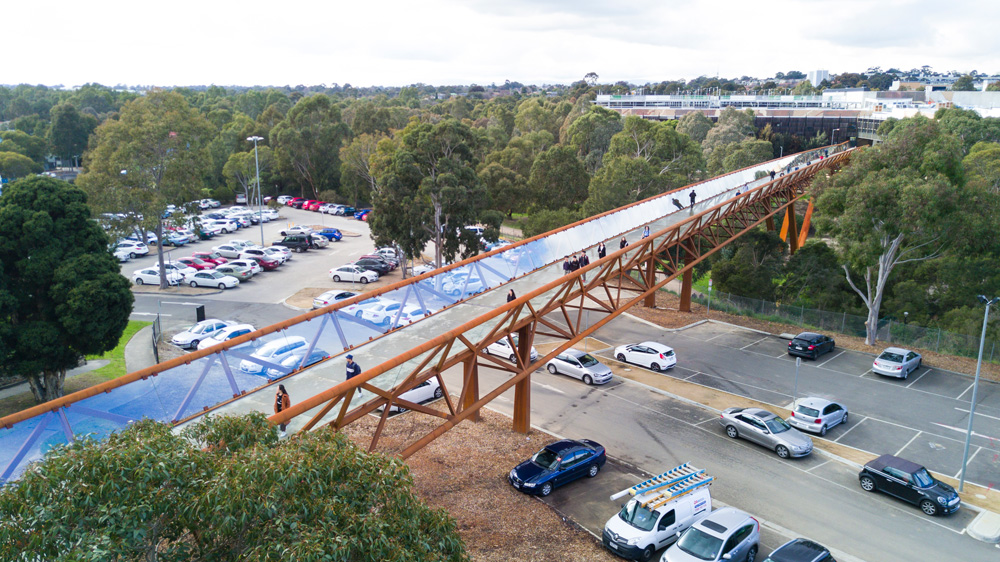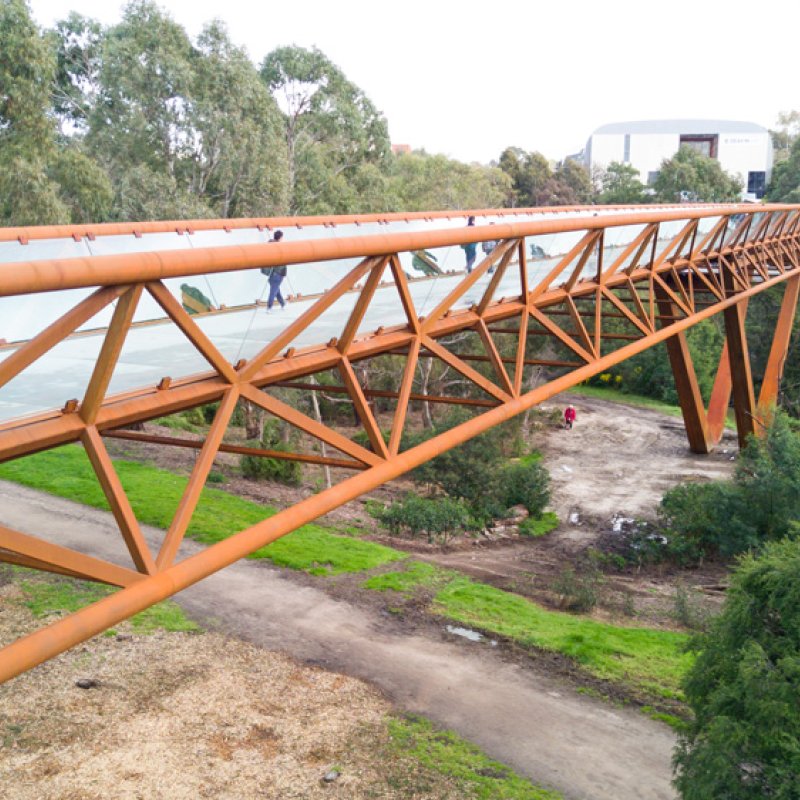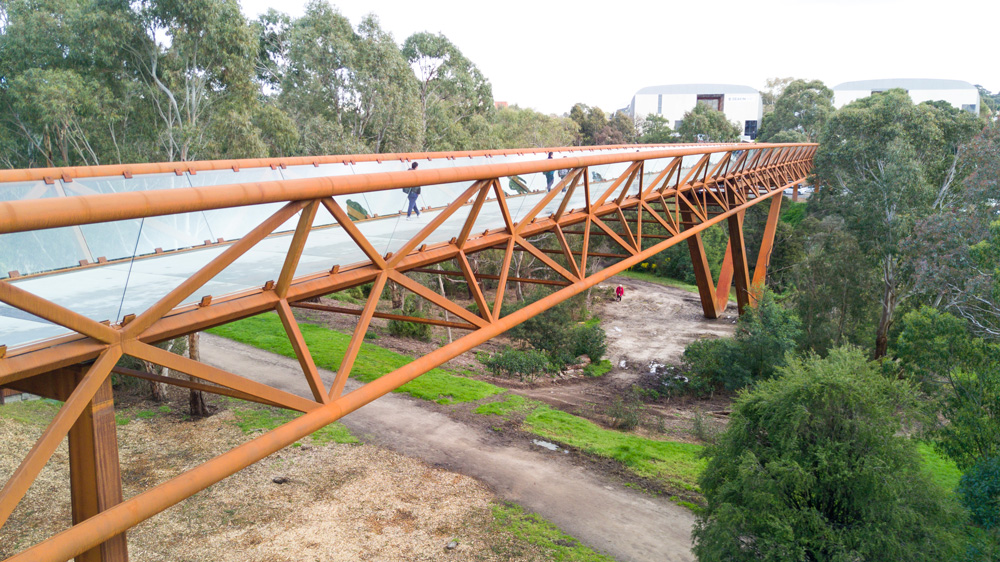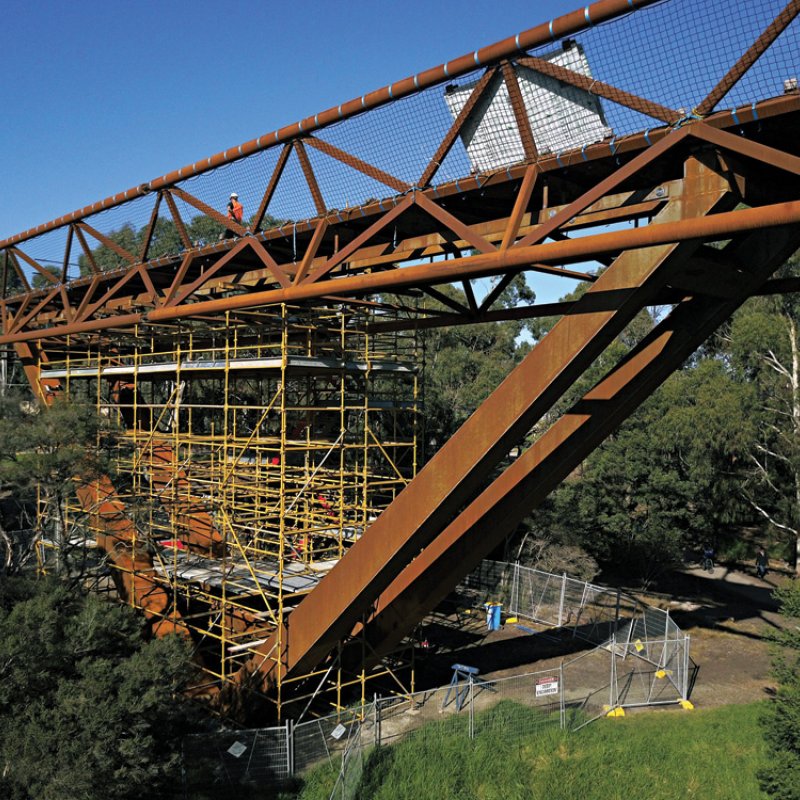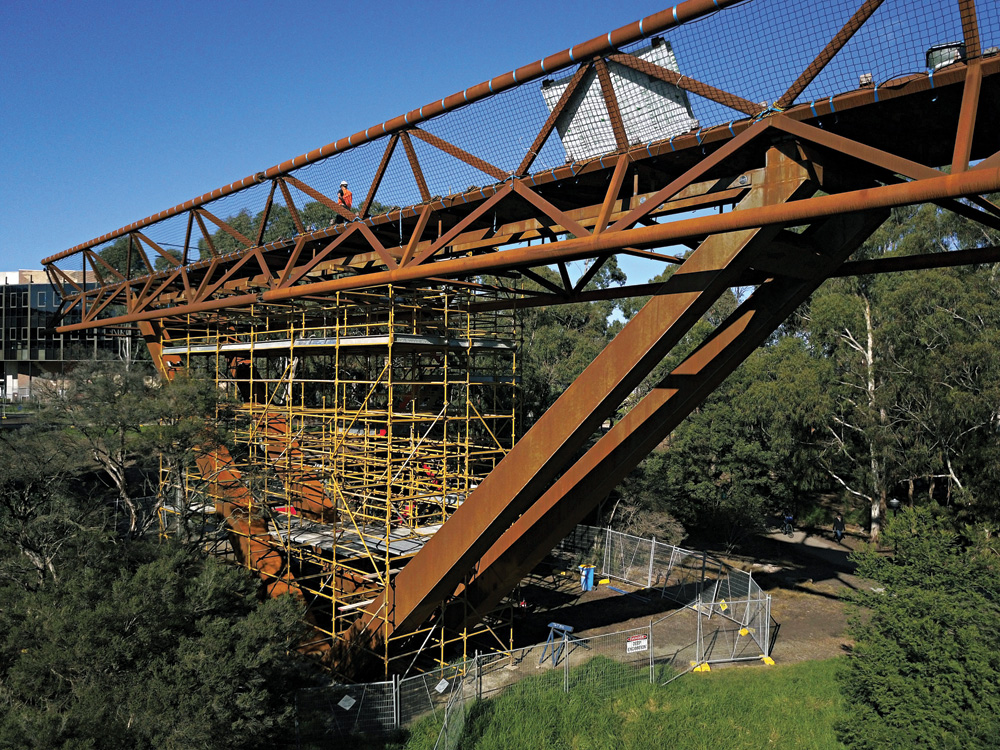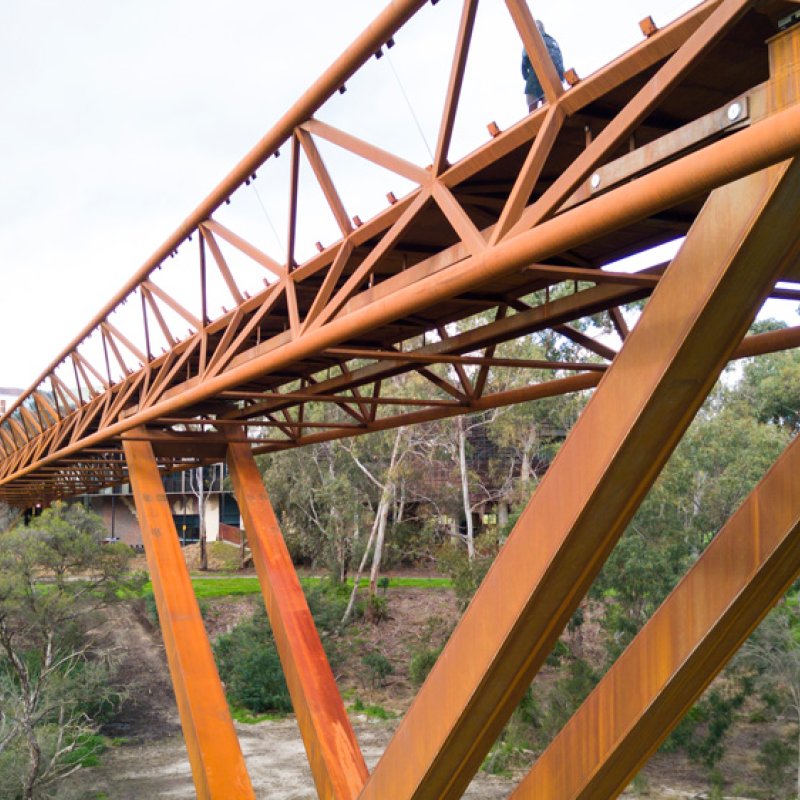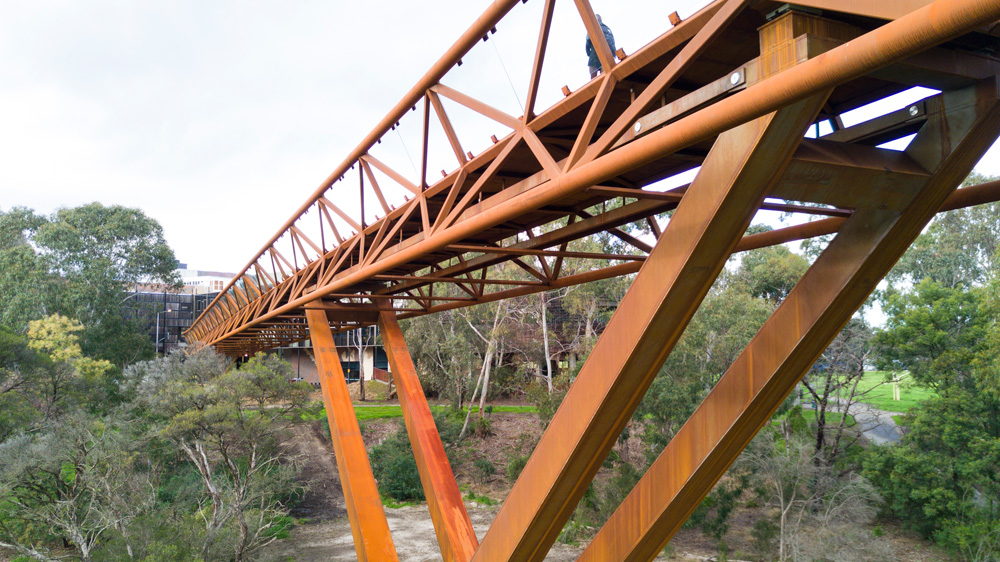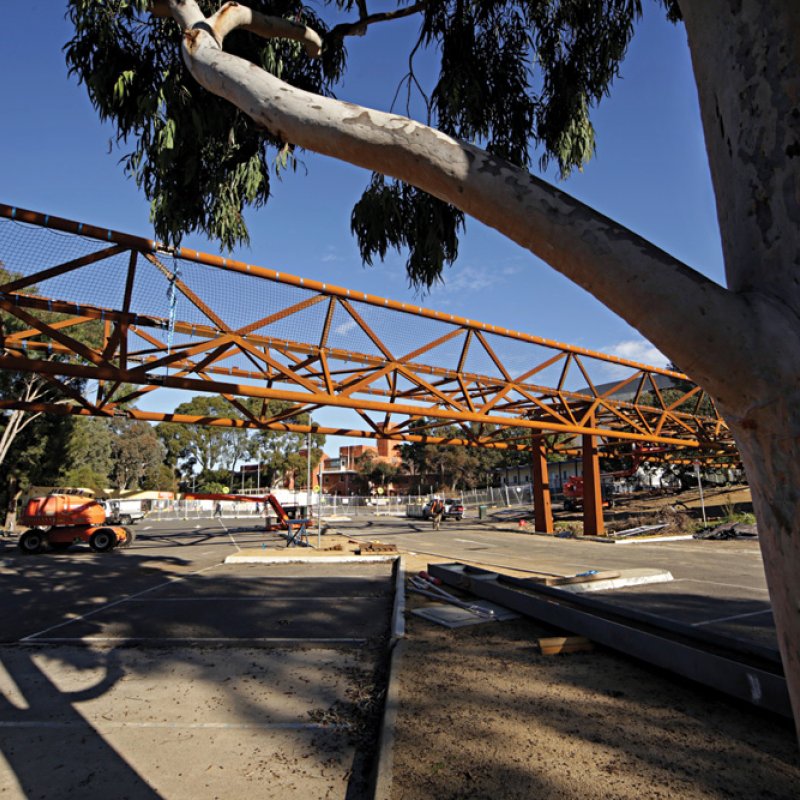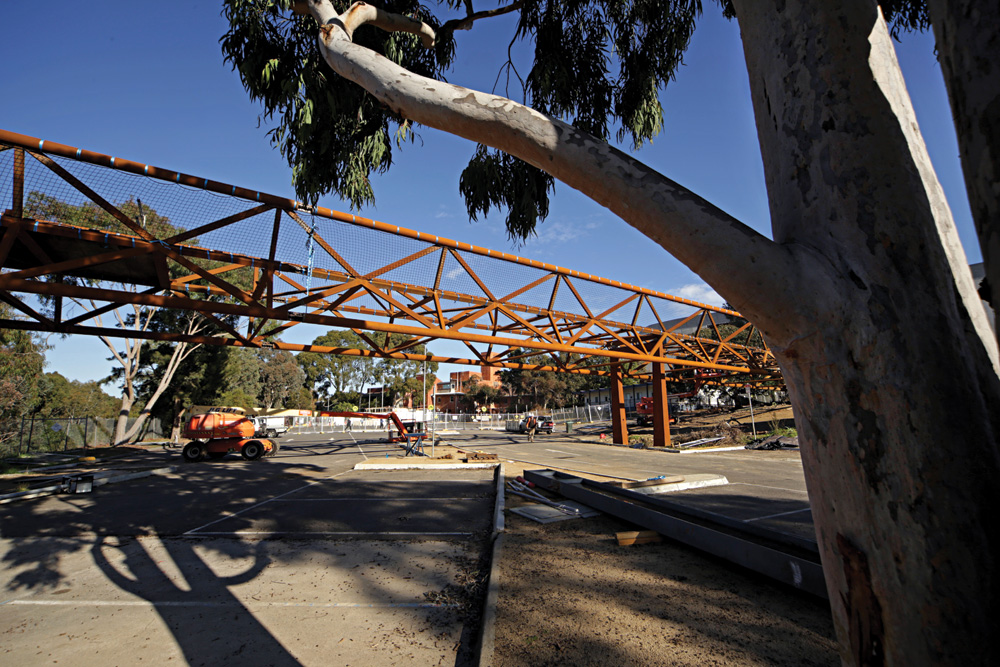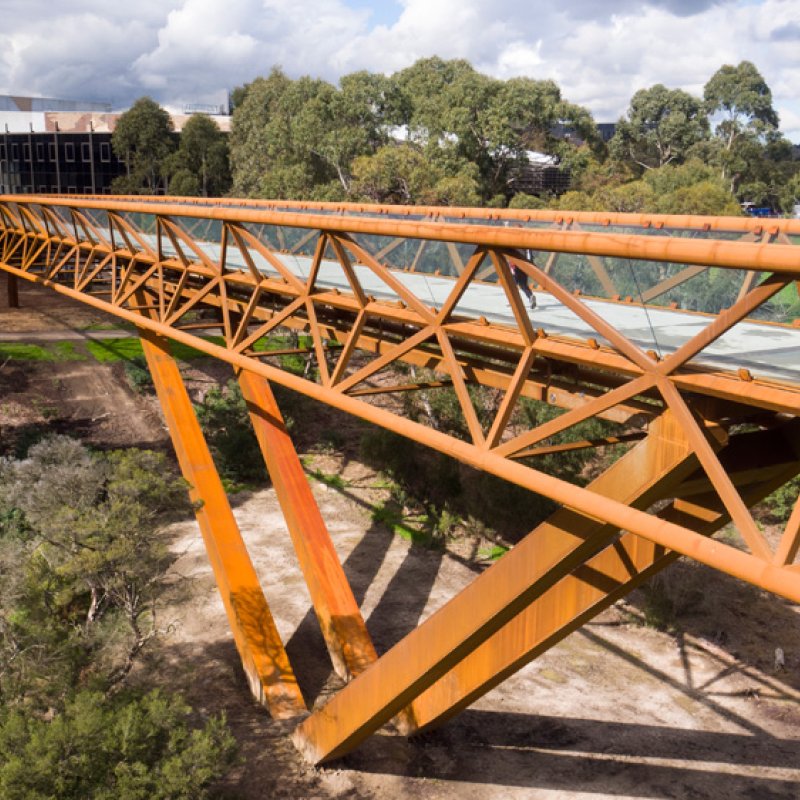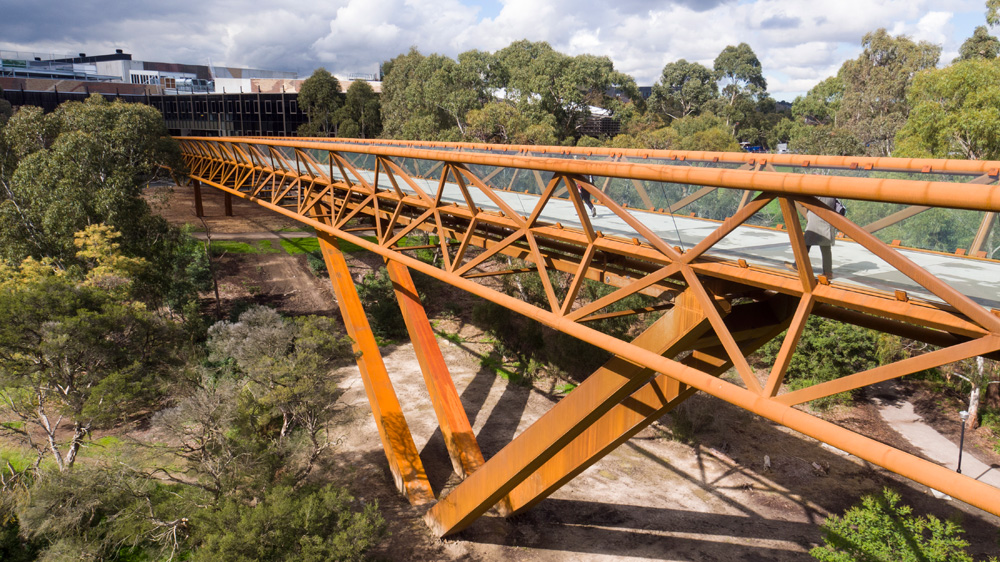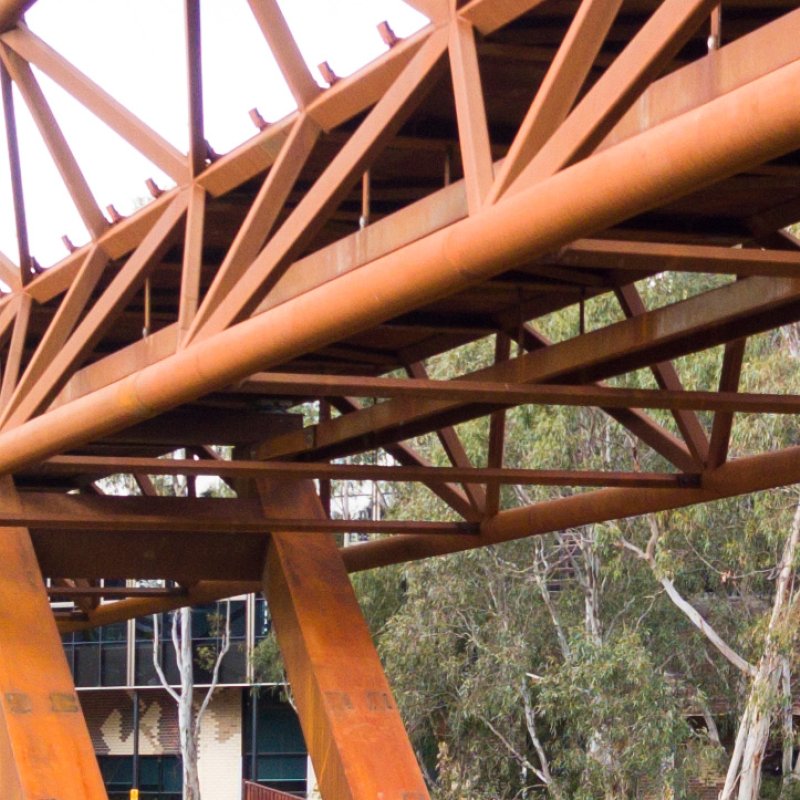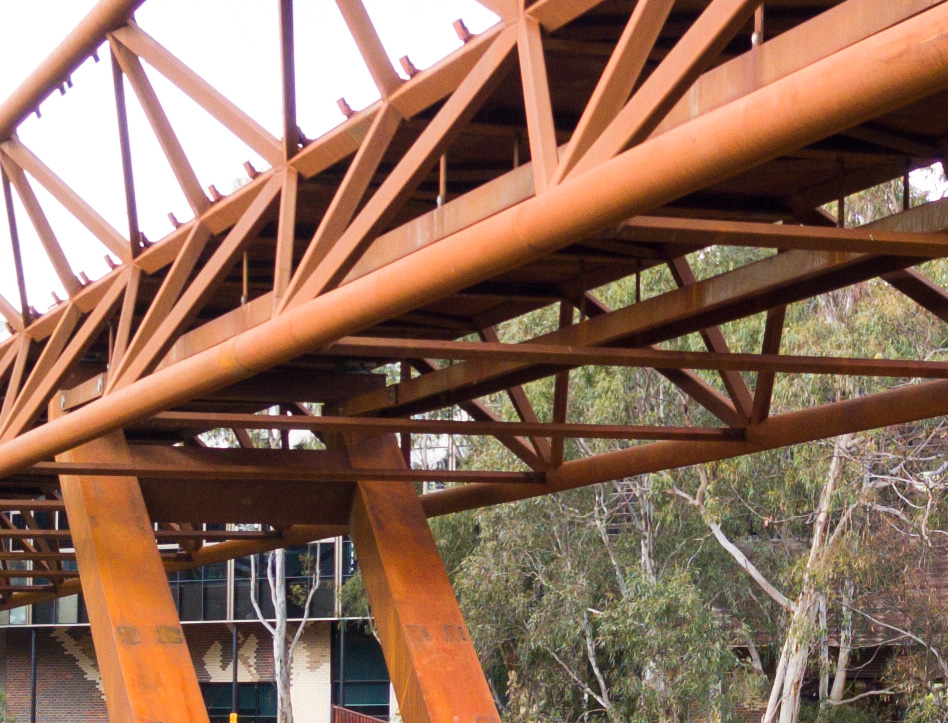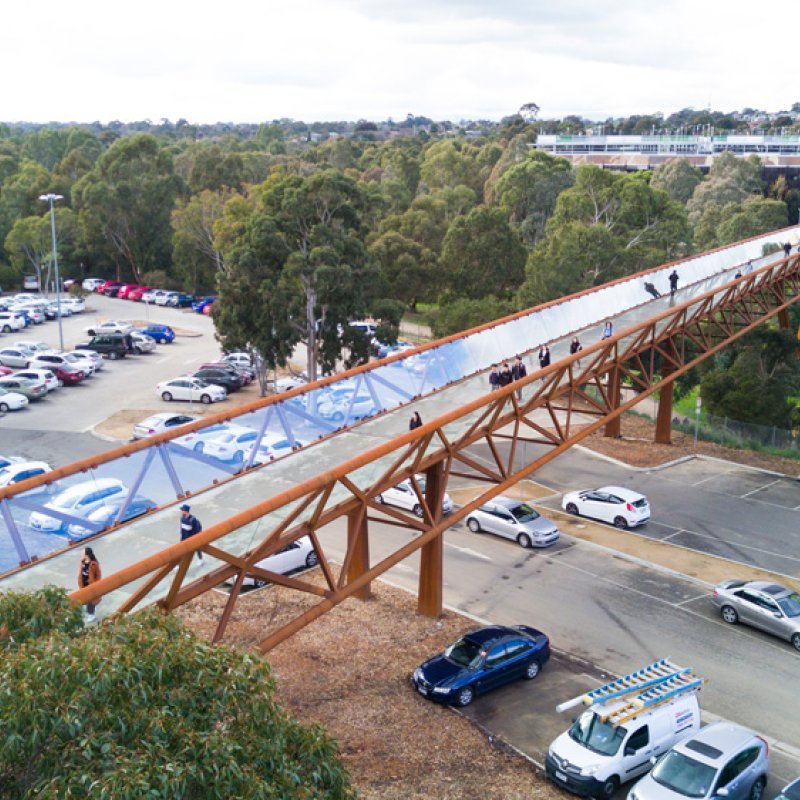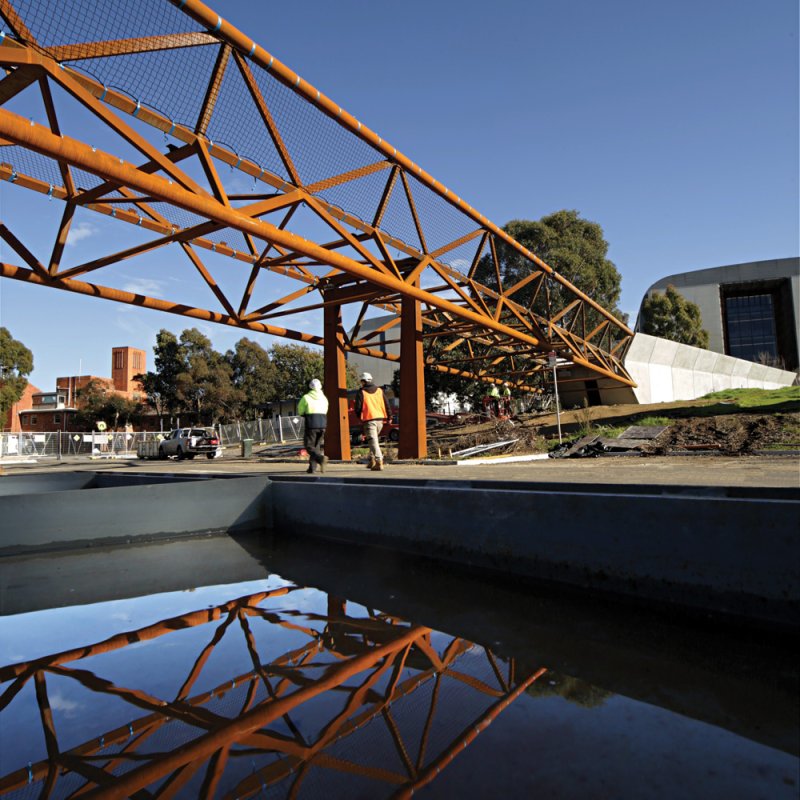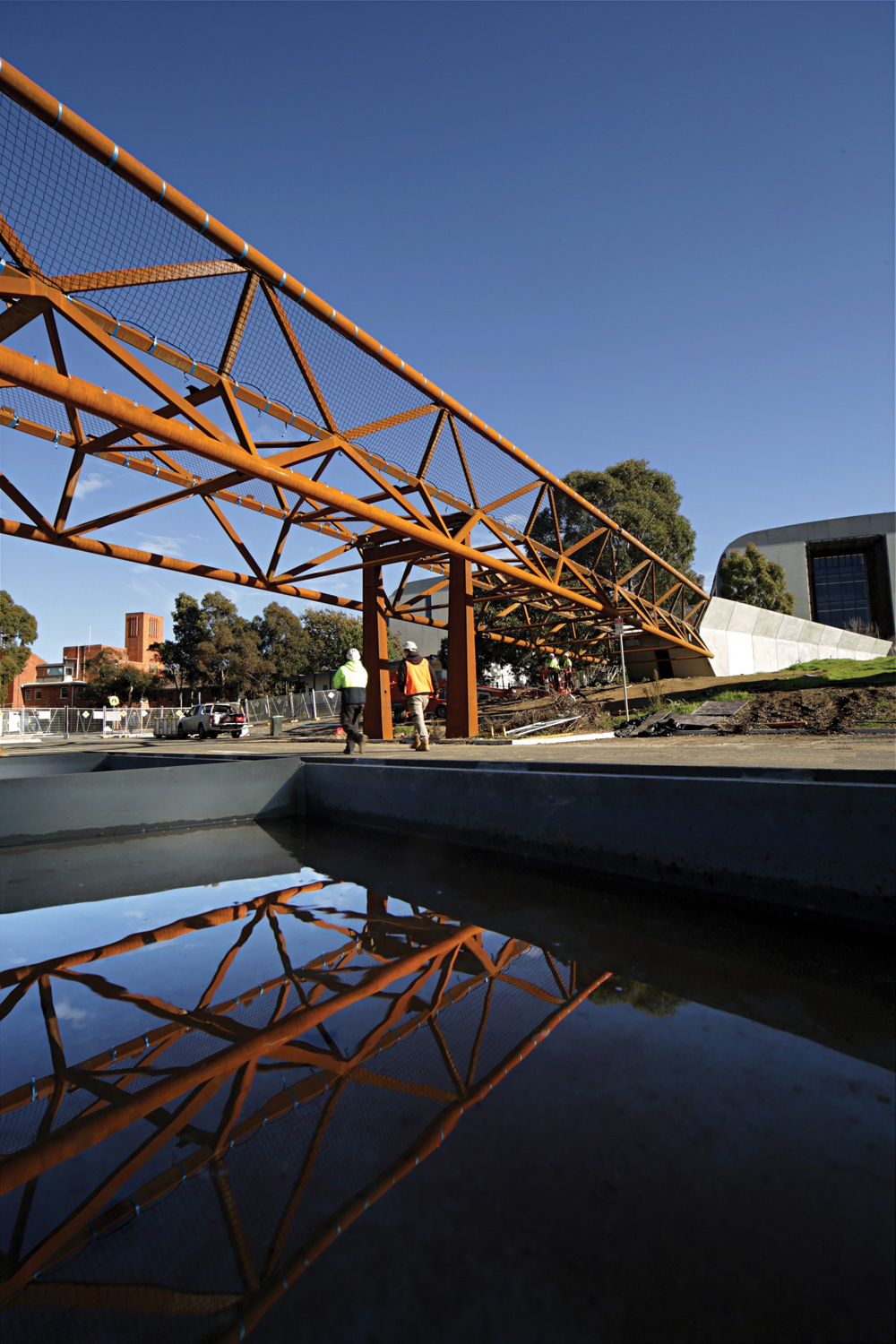Steel Bridge Goes Above and Beyond
A new pedestrian bridge that connects Deakin University’s two Burwood campuses – divided by Gardiners Creek in Melbourne’s eastern suburbs – uses BlueScope REDCOR® weathering steel to deliver a practical, paint-free structure requiring minimal maintenance compared with conventional structural steel. Thus by avoiding the need to paint (and re-paint) structures, REDCOR® weathering steel can contribute to improving a structure’s sustainability.
Building on his early professional experience in London working for Grimshaw and Foster + Partners, Melbourne-based architect Rob Watson – who discloses a preoccupation with bridges in all their forms – has designed a symmetrical three-dimensional modular bridge structure that addresses several key challenges.
The first of these is access. While there was a small existing bridge across the creek, it sat at-grade and was only accessible by stairs on the Elgar Road bank. Any new bridge had to comply with the requirements of the Disability Discrimination Act and provide safe and easy passage for people of all abilities. Secondly, because the creek corridor is titled Crown Land (the parcels on either side are owned by the University) the flyover section had to be low maintenance, and to allow for quick and easy access for cleaning and repairs, to avoid protracted and costly access permits. Thirdly, the bridge had to blend in with its native bush surroundings, an especially important consideration because a previous proposal – which arose from a design competition scheme in 2005 – had proved controversial within the local community and was later scrapped.
As part of his solution to address these challenges, Rob Watson chose to build the new 250 metre-long bridge using weathering steel, including 200 tonnes of REDCOR® weathering steel in grades WR350BL0 and HW350A. He said weathering steel requires low maintenance over its lifespan, and its appearance helps the bridge blend into the native bush surroundings. Watson devised an innovative structural system – which includes an 85 metre-long central section that sits above the parcel of Crown Land, touching the ground at just one point via two V-shaped steel pylons – that minimised the bridge’s impact on the creek corridor, both during initial construction and throughout its projected lifespan.
“While there are some excellent paint systems available for steel structures, on this project any painting would have been problematic,” Rob Watson said.
“The bridge has a lifespan of 100-plus years, so it would have needed to be painted three or four times during its life. Not only did the weathering steel provide an acceptable appearance to the community, the fact that you don’t need to maintain it such as is the case with an applied protective coating system, apart from basic cleaning, was very appealing from a whole design life perspective.”
Rob Watson, watsonarchitecture+design
The bridge comprises a series of repetitive modular bays – each about four metres long by four metres wide – that were connected to form a series of six trusses which range in length from 16.5 metres to 47 metres. The walkway deck consists of concrete panels cast in permanent formwork trays made from REDCOR® weathering steel in grade HW350A. They give the underside of the bridge the same appearance as the rest of the structure, so that the weathering steel finish is visible from every conceivable angle.
Rob Watson’s vision was turned into a buildable reality with WSP Structures; modelled and steel detailed by PlanIT Design Group; fabricated off-site by Sutcliffe Engineering; and erected by Head Contractor Kane Constructions with Associated Rigging and Metcalf Cranes.
PlanIT design director Ricky Hains said that working with the architect’s 3D model as a reference point helped to achieve the rigorous geometry and tight tolerances that the project demanded. “There was a process whereby our steel models were fed back into Rob’s design model to ensure the geometric accuracy and the coordination of the other elements, such as the glass, the glass brackets, and the precast panels,” Ricky Hains said. “Rob and I worked well together interchanging our models and then making any adjustments that were required.”
According to Kane Constructions project manager Mark Spolidoro, the unusual and complex geometry of the bridge posed different challenges to Kane’s regular projects, which include significant health and education facilities. That complexity was compounded by the fact that access to the creek-side walking paths and the existing crossing – which was traversed by about 43,000 people each week – had to be maintained throughout construction.
“I wouldn’t say it was easy, but we planned it all in minute detail, and each plan was peer reviewed in detail by independent members of our team. We didn’t have any major issues onsite,” Mark Spolidoro said. “But I had a few sleepless nights before we started.”
Mark Spolidoro, Project Manager, Kane Constructions
Mark Spolidoro attributes the smooth construction program to the exacting steel detailing and precise prefabrication by the sub-contractors, as well as Kane’s stringent planning.
“PlanIT’s Ricky Hains and Nick Palamaras of Sutcliffe Engineering went out of their way to ensure the best outcome possible,” Mark Spolidoro said. “You need people like that on a project like this, because although the structure is repetitive, there is a slight curve in the elevation of the bridge, and each section was cambered, so the steel detailing and junctions were complex.”
Like the bridge, the junctions were designed to appear elegant and efficient, particularly because access for future maintenance would be limited, Rob Watson explains. “We studied every junction carefully, to make them look as elegant as possible, and we also designed them so as not to trap water or dirt,” he said. “Originally, Macalloy bars were designed to tie V-pylons together, but in conjunction with Kane we decided to go with 32mm-thick plates made from BlueScope REDCOR® weathering steel in grade WR350BL0 with a pin joint, using 85mm diameter Duplex stainless steel pins, to tie the heads of the two V-pylons.”
As the project moved towards the site erection stage, Kane, along with Associated Rigging and temporary works Engineer Andrew Baigent, devised a detailed works sequence and methodology plan that outlined each step in the rigging process, focusing on safety and build-ability. “The tolerances we were working with were minimal,” Mark Spolidoro said. “From pin to pin, between the tie member plates – a distance of approximately 25 metres – we had a tolerance of just 1mm.
“We also undertook a lot of preliminary work to survey and check the dimensions,” said Nick Palamaras, director of Sutcliffe Engineering. “We couldn’t trial-assemble it, but we did everything in our power to make sure that when the long truss sections arrived at the site, they were near perfect and would fit.”
The bridge supports and walkway truss bays were transported in lengths of about 25 metres, and a decision to change welded truss splice connections to bolted connections shaved two weeks’ worth of site welding from the program. After the trusses were bolted together on the ground, the sections were lifted into place by one of Australia’s largest mobile cranes – Metcalf Cranes’ 600 tonne Demag TC2800- 1 – which was located in a carpark on the Elgar Road side for just over two weeks.
“That was a very intense period,” Watson recalls. “We had a huge mobile crane on the embankment, not because of the weight of the parts, but to reach 65 metres into the creek corridor, sometimes with 50 metre-long elements hanging off the jib.”
Unusually, steel detailer Ricky Hains was involved with the erection of the central V-pylons onsite. “Ricky was always there to assist on the temporary components, and went beyond his scope to assist us,” Mark Spolidoro said.
“We don’t normally get involved with drawing temporary and erection works,” Ricky Hains conceded, “But in this case, we modelled and detailed additional props and lifting points, and temporary brackets, to erect the big central V-pylons.
“Once the V-pylons and four middle truss sections were in place, Kane shifted to 350- and 200-tonne cranes for the remaining sections,” Rob Watson explains. “The deck trays went on progressively after each truss section was installed, providing a progressive safe working deck. The deck trays are made from 3mm-thick REDCOR® weathering steel in grade HW350B, which was fabricated 140mm deep, in the fashion of baking trays, to act as permanent formwork for the concrete deck panels.”
According to Nick Palamaras, there was never any danger that the structure wouldn’t go together as easily as a perfectly cut jigsaw puzzle, once it reached the site. “We had contracted an independent surveyor to visit the factory and site beforehand, to double-check the survey against the PlanIT Designs model,” he said.
“I knew it was all going to go together beautifully, and when we set it over the bearings, it fitted exactly into place.”
Nick Palamaras, Director, Sutcliffe Engineering
As a result of Rob Watson’s fully integrated and symmetrical structure, the bridge appears to extend effortlessly across the creek corridor. From a distance, and from certain vantage points along the creek-side walking paths, it can be seen protruding delicately above the tree canopy. The hovering effect is amplified by the integrated hand-rail and safety enclosure system, which features ‘barely there’ frameless 17mm-thick clear glass panels, mounted on hinges at the base so the glass can pivot inwards for cleaning. “From a distance, all you can see is the structure and the people walking across it,” he said. “It looks deceptively simple, but it took a bit of work.”
So after a false start with a community backlash against the first proposed design, the Deakin University community and local residents finally have a bridge across Gardiners Creek that is accessible to everyone. And, according to local reports, the community is pleased with its striking, sprawling weathering steel structure that boasts the unusual ability to both blend in and stand out.
